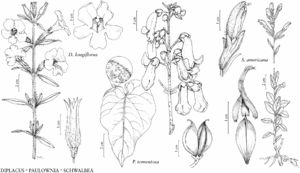Difference between revisions of "Paulowniaceae"
FNA>Volume Importer |
FNA>Volume Importer |
||
| Line 18: | Line 18: | ||
|distribution=e Asia;introduced also in Europe. | |distribution=e Asia;introduced also in Europe. | ||
|discussion=<p>Genus 1, species 7 (1 in the flora).</p><!-- | |discussion=<p>Genus 1, species 7 (1 in the flora).</p><!-- | ||
| − | --><p>Paulownia has been allied with Bignoniaceae or Scrophulariaceae based on morphological, anatomical, and embryological evidence (D. H. Campbell 1930; J. E. Armstrong 1985). Molecular phylogenetic evidence showed that it does not belong with Bignoniaceae or Scrophulariaceae; instead it is an isolated lineage near Lamiaceae, Orobanchaceae, and Phrymaceae (R. G. Olmstead et al. 2001; B. Oxelman et al. 2005).</p> | + | --><p><i>Paulownia</i> has been allied with Bignoniaceae or Scrophulariaceae based on morphological, anatomical, and embryological evidence (D. H. Campbell 1930; J. E. Armstrong 1985). Molecular phylogenetic evidence showed that it does not belong with Bignoniaceae or Scrophulariaceae; instead it is an isolated lineage near Lamiaceae, Orobanchaceae, and Phrymaceae (R. G. Olmstead et al. 2001; B. Oxelman et al. 2005).</p> |
|tables= | |tables= | ||
|references={{Treatment/Reference | |references={{Treatment/Reference | ||
| Line 55: | Line 55: | ||
|publication year= | |publication year= | ||
|special status= | |special status= | ||
| − | |source xml=https://jpend@bitbucket.org/aafc-mbb/fna-data-curation.git/src/ | + | |source xml=https://jpend@bitbucket.org/aafc-mbb/fna-data-curation.git/src/8f726806613d60c220dc4493de13607dd3150896/coarse_grained_fna_xml/V17/V17_1.xml |
}}<!-- | }}<!-- | ||
-->[[Category:Treatment]] | -->[[Category:Treatment]] | ||
Revision as of 14:55, 18 September 2019
Trees, not fleshy, autotrophic. Leaves deciduous [persistent], cauline, opposite, rarely in whorls of 3, simple; stipules absent; petiole present; blade not fleshy, not leathery, margins entire or shallowly 3(–5)-lobed and usually serrate to dentate on leaves of young plants. Inflorescences terminal thyrses of (1–)3–8(–11)-flowered cymes. Flowers bisexual, perianth and androecium hypogynous; sepals 5, connate, calyx bilaterally symmetric; petals 5, connate, corolla bilaterally symmetric, bilabiate, funnelform; stamens 4, proximally adnate to corolla, didynamous, staminode 0; pistil 1, 2-carpellate, ovary superior, 2-locular, placentation axile; ovules anatropous, unitegmic, tenuinucellate; style 1; stigma 1. Fruits capsules, dehiscence loculicidal. Seeds ca. 2000, brown, ellipsoid; embryo straight, endosperm present.
Distribution
e Asia, introduced also in Europe.
Discussion
Genus 1, species 7 (1 in the flora).
Paulownia has been allied with Bignoniaceae or Scrophulariaceae based on morphological, anatomical, and embryological evidence (D. H. Campbell 1930; J. E. Armstrong 1985). Molecular phylogenetic evidence showed that it does not belong with Bignoniaceae or Scrophulariaceae; instead it is an isolated lineage near Lamiaceae, Orobanchaceae, and Phrymaceae (R. G. Olmstead et al. 2001; B. Oxelman et al. 2005).
